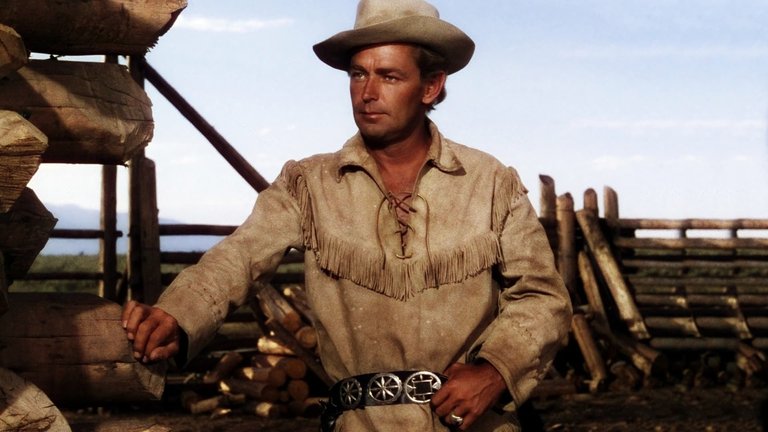Film Review: Shane (1953)

In 1950s Western films reached peak of its popularity, resulting in large number being made, both on big and small screen. This large quantity reflected itself in quality, with high number of films earning the reputation of the best and the most iconic in the history of the genre. One of such classics was Shane, 1953 film directed by George Stevens.
The film is based on 1949 eponymous novel by Jack Schaeffer, partially inspired by Johnson County War, series of events that had inspired classic Western novel Virginian, as well as Cimino’s unfortunate Heaven’s Gate. The plot is set in 1889 Wyoming Territory and begins when mysterious stranger called Shane (played by Alan Ladd) arrives to homestead owned by Joe Starrett (played by Van Hefflin). While Shane doesn’t talk about his past, it is all but understood that he is or used to be gunslinger, but now, apparently he starts new life and volunteers to work as Starrett’s ranch hand. He quickly befriends Joe’s young son Joey (played by Brandon deWilde), who idolises him, just as he has caught attention of Joe’s wife Marian (played by Jean Arthur). Starretts, however, have serious problem that they share with all homesteaders at the valley. Rufus Ryker (played by Emile Meyer) is cattle baron who considers entire valley as his own and wants to chase away homesteaders through intimidation. This lead to physical altercation during which Shane successfully stands up to thugs. Ryker is now considering hiring outside help in the form of equally mysterious but deadly gunslinger Jack Wilson (played by Jack Palance).
Shane is a very simple film that adheres to Western formula by mixing bits of actual history with American nation-building myths and more archetypal stories and characters about struggle between Good and Evil. Yet, although it might, on the first glance, look cliched, this film employs that formula in an interesting way, that was quite refreshing for its time. One of the more interesting aspects is unusual but inspired casting. The most notable is Alan Ladd, an actor known for his short stature who nevertheless added to realism to the film by portraying person who, by necessity, chose to use guns instead of fists to survive, while at the same time, projecting ability to deceive potential enemies by acting effeminate and weaker than he actually is. Jean Arthur, who briefly ended her retirement, stars in her last feature film and convincingly plays both motherly figure and romantic interest, despite being fifty at the time of production. Child actor Brandon deWilde is also very good in his role. Van Hefflin as head of family is solid, but his performance is overshadowed by Jack Palance's menacing presence in his first film role, as well as character actor Emile Meyer who plays intelligent villain that relies on more than simple violence to achieve his aims and who is even given opportunity to explain his case to other characters and the audience.
Shane also represented a transition towards more realistic depictions of violence in Westerns, notably seen in the brutal killing of Torrey (played by Elisha Cook Jr.), character proud Southerner who is dispatched quickly and with help of special effects and other techniques that made the body of gunshot victim behave in authentic way. Stevens, who had been inspired by his experiences in Second World War, thus paved the way for trend of increasingly bloody and gory Westerns that would find its zenith in works of Sam Peckinpah decade and half later.
Script by A. B. Guthrie Jr. intelligently narrates events through a child's perspective, leaving Shane's character, both his ulterior motives and the ultimate fate following iconic ending, shrouded in mystery and open to various interpretations. George Stevens' direction effectively utilizes scenic Wyoming locations, making the two-hour film engaging and visually captivating. While Loyal Griggs' colour cinematography is generally well-used, it falls short during "day for night" scenes. Victor Young's music score is deemed underwhelming, not fully complementing the film's emotional depth. Despite some criticisms, Shane quickly became a classic in Western cinema and maintained its reputation to this day, often serving as template for various remakes, both those in realm of the genre, like Clint Eastwood’s Pale Rider, or those in different genres like generic action in Nowhere to Run or science fiction in Soldier.
RATING: 8/10 (+++)
Blog in Croatian https://draxblog.com
Blog in English https://draxreview.wordpress.com/
InLeo blog https://inleo.io/@drax.leo
Hiveonboard: https://hiveonboard.com?ref=drax
Rising Star game: https://www.risingstargame.com?referrer=drax
1Inch: https://1inch.exchange/#/r/0x83823d8CCB74F828148258BB4457642124b1328e
BTC donations: 1EWxiMiP6iiG9rger3NuUSd6HByaxQWafG
ETH donations: 0xB305F144323b99e6f8b1d66f5D7DE78B498C32A7
Posted using CineTV
Thats seem a nice film